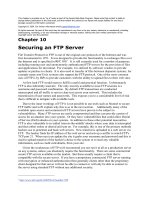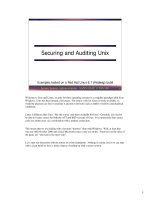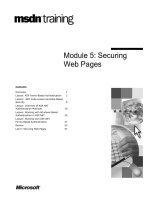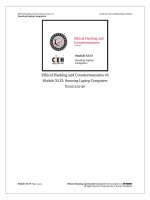Securing hadoop
Bạn đang xem bản rút gọn của tài liệu. Xem và tải ngay bản đầy đủ của tài liệu tại đây (4.31 MB, 116 trang )
www.it-ebooks.info
Securing Hadoop
Implement robust end-to-end security for your
Hadoop ecosystem
Sudheesh Narayanan
BIRMINGHAM - MUMBAI
www.it-ebooks.info
Securing Hadoop
Copyright © 2013 Packt Publishing
All rights reserved. No part of this book may be reproduced, stored in a retrieval
system, or transmitted in any form or by any means, without the prior written
permission of the publisher, except in the case of brief quotations embedded in
critical articles or reviews.
Every effort has been made in the preparation of this book to ensure the accuracy
of the information presented. However, the information contained in this book is
sold without warranty, either express or implied. Neither the author, nor Packt
Publishing, and its dealers and distributors will be held liable for any damages
caused or alleged to be caused directly or indirectly by this book.
Packt Publishing has endeavored to provide trademark information about all of the
companies and products mentioned in this book by the appropriate use of capitals.
However, Packt Publishing cannot guarantee the accuracy of this information.
First published: November 2013
Production Reference: 1181113
Published by Packt Publishing Ltd.
Livery Place
35 Livery Street
Birmingham B3 2PB, UK.
ISBN 978-1-78328-525-9
www.packtpub.com
Cover Image by Ravaji Babu ()
www.it-ebooks.info
Credits
Author
Project Coordinator
Sudheesh Narayanan
Reviewers
Akash Poojary
Proofreader
Mark Kerzner
Ameesha Green
Nitin Pawar
Indexer
Rekha Nair
Acquisition Editor
Antony Lowe
Graphics
Commissioning Editor
Shaon Basu
Sheetal Aute
Ronak Dhruv
Valentina D'silva
Technical Editors
Amit Ramadas
Amit Shetty
Disha Haria
Abhinash Sahu
Production Coordinator
Nilesh R. Mohite
Cover Work
Nilesh R. Mohite
www.it-ebooks.info
About the Author
Sudheesh Narayanan is a Technology Strategist and Big Data Practitioner with
expertise in technology consulting and implementing Big Data solutions. With over
15 years of IT experience in Information Management, Business Intelligence, Big Data
& Analytics, and Cloud & J2EE application development, he provided his expertise
in architecting, designing, and developing Big Data products, Cloud management
platforms, and highly scalable platform services. His expertise in Big Data includes
Hadoop and its ecosystem components, NoSQL databases (MongoDB, Cassandra,
and HBase), Text Analytics (GATE and OpenNLP), Machine Learning (Mahout,
Weka, and R), and Complex Event Processing.
Sudheesh is currently working with Genpact as the Assistant Vice President
and Chief Architect – Big Data, with focus on driving innovation and building
Intellectual Property assets, frameworks, and solutions. Prior to Genpact, he was
the co-inventor and Chief Architect of the Infosys BigDataEdge product.
I would like to thank my wife, Smita and son, Aryan for their
sacrifices and support during this journey, and my dad, mom,
and sister for encouraging me at all times to make a difference by
contributing back to the community. This book would not have been
possible without their encouragement and constant support.
Special thanks to Rupak and Debika for investing their personal time
over weekends to help me experiment with a few ideas on Hadoop
security, and for being the bouncing board.
I would like to thank Shwetha, Sivaram, Ajay, Manpreet, and Venky
for providing constant feedback and helping me make continuous
improvements in my securing Hadoop journey.
Above all, I would like to acknowledge my sincere thanks to my
teacher, Prof. N. C. Jain; my leaders and coach Paddy, Vishnu Bhat,
Sandeep Bhagat, Jaikrishnan, Anil D'Souza, and KNM Rao for their
mentoring and guidance in making me who I am today, so that I
could write this book.
www.it-ebooks.info
About the Reviewers
Mark Kerzner holds degrees in Law, Math, and Computer Science. He has been
designing software for many years and Hadoop-based systems since 2008. He is
the President of SHMsoft, a provider of Hadoop applications for various verticals,
and a co-author of the Hadoop illuminated book/project. He has authored and
co-authored books and patents.
I would like to acknowledge the help of my colleagues, in particular,
Sujee Maniyam, and last but not the least, my multitalented family.
Nitin Pawar started his career as a Release Engineer and Tools Developer, then
moved into different roles such as operations, solutions engineering, process
engineering, and Big Data analytics. Currently, he is working as a Big Data System
Architect, and trying to solve problems related to customer success management.
He has mainly been working with technologies revolving around the first generation
Hadoop ecosystem.
www.it-ebooks.info
www.PacktPub.com
Support files, eBooks, discount offers
and more
You might want to visit www.PacktPub.com for support files and downloads related to
your book.
Did you know that Packt offers eBook versions of every book published, with PDF and
ePub files available? You can upgrade to the eBook version at www.PacktPub.com and
as a print book customer, you are entitled to a discount on the eBook copy. Get in touch
with us at for more details.
At www.PacktPub.com, you can also read a collection of free technical articles, sign up
for a range of free newsletters and receive exclusive discounts and offers on Packt books
and eBooks.
TM
Do you need instant solutions to your IT questions? PacktLib is Packt's online digital
book library. Here, you can access, read and search across Packt's entire library of books.
Why Subscribe?
• Fully searchable across every book published by Packt
• Copy and paste, print and bookmark content
• On demand and accessible via web browser
Free Access for Packt account holders
If you have an account with Packt at www.PacktPub.com, you can use this to access
PacktLib today and view nine entirely free books. Simply use your login credentials for
immediate access.
www.it-ebooks.info
Table of Contents
Preface1
Chapter 1: Hadoop Security Overview
7
Why do we need to secure Hadoop?
8
Challenges for securing the Hadoop ecosystem
9
Key security considerations
10
Reference architecture for Big Data security
11
Summary12
Chapter 2: Hadoop Security Design
13
Chapter 3: Setting Up a Secured Hadoop Cluster
25
What is Kerberos?
13
Key Kerberos terminologies
14
How Kerberos works?
15
Kerberos advantages
16
The Hadoop default security model without Kerberos
17
Hadoop Kerberos security implementation
19
User-level access controls
19
Service-level access controls
19
User and service authentication
20
Delegation Token
20
Job Token
20
Block Access Token
21
Summary23
Prerequisites25
Setting up Kerberos
26
Installing the Key Distribution Center
27
Configuring the Key Distribution Center
Establishing the KDC database
Setting up the administrator principal for KDC
www.it-ebooks.info
29
31
32
Table of Contents
Starting the Kerberos daemons
Setting up the first Kerberos administrator
Adding the user or service principals
Configuring LDAP as the Kerberos database
Supporting AES-256 encryption for a Kerberos ticket
32
33
33
33
33
Configuring Hadoop with Kerberos authentication
Setting up the Kerberos client on all the Hadoop nodes
Setting up the Hadoop service principals
34
34
35
Configuring users for Hadoop
Automation of a secured Hadoop deployment
Summary
42
43
43
Creating a keytab file for Hadoop services
Distributing the keytab file for all the slaves
Setting up Hadoop configuration files
HDFS-related configurations
MRV1-related configurations
MRV2-related configurations
Setting up secured DataNode
Setting up the TaskController class
Chapter 4: Securing the Hadoop Ecosystem
Configuring Kerberos for Hadoop ecosystem components
Securing Hive
Securing Hive using Sentry
Securing Oozie
Securing Flume
35
36
36
37
38
39
40
40
45
46
46
49
49
52
Securing Flume sources
Securing Hadoop sink
Securing a Flume channel
53
54
55
Securing HBase
55
Securing Sqoop
59
Securing Pig
60
Best practices for securing the Hadoop ecosystem components
61
Summary62
Chapter 5: Integrating Hadoop with Enterprise Security Systems
63
Integrating Enterprise Identity Management systems
64
Configuring EIM integration with Hadoop
66
Integrating Active-Directory-based EIM with the Hadoop ecosystem
66
Accessing a secured Hadoop cluster from an enterprise network
67
HttpFS
68
HUE69
Knox Gateway Server
71
Summary72
[ ii ]
www.it-ebooks.info
Table of Contents
Chapter 6: Securing Sensitive Data in Hadoop
Securing sensitive data in Hadoop
Approach for securing insights in Hadoop
Securing data in motion
Securing data at rest
Implementing data encryption in Hadoop
73
74
75
75
76
78
Summary80
Chapter 7: Security Event and Audit Logging in Hadoop
81
Appendix: Solutions Available for Securing Hadoop
89
Security Incident and Event Monitoring in a Hadoop Cluster
82
The Security Incident and Event Monitoring (SIEM) system
84
Setting up audit logging in a secured Hadoop cluster
86
Configuring Hadoop audit logs
86
Summary88
Hadoop distribution with enhanced security support
89
Automation of a secured Hadoop cluster deployment
90
Cloudera Manager
90
Zettaset91
Different Hadoop data encryption options
91
Dataguise for Hadoop
91
Gazzang zNcrypt
92
eCryptfs for Hadoop
92
Securing the Hadoop ecosystem with Project Rhino
92
Mapping of security technologies with the reference architecture
93
Infrastructure security
93
OS and filesystem security
94
Application security
94
Network perimeter security
94
Data masking and encryption
94
Authentication and authorization
94
Audit logging, security policies, and procedures
95
Security Incident and Event Monitoring
95
Index97
[ iii ]
www.it-ebooks.info
www.it-ebooks.info
Preface
Today, many organizations are implementing Hadoop in production environments.
As organizations embark on the Big Data implementation journey, security of Big
Data is one of the major concerns. Securing sensitive data is one of the top priorities
for organizations. Enterprise security teams are worried about integrating Hadoop
security with enterprise systems. Securing Hadoop provides a detailed implementation
and best practices for securing a Hadoop-based Big Data platform. It covers the
fundamentals behind Kerberos security and Hadoop security design, and then details
the approach for securing Hadoop and its ecosystem components within an enterprise
context. The goal of this book is to take an end-to-end enterprise view on Big Data
security by looking at the Big Data security reference architecture, and detailing
how the various building blocks required by an organization can be put together to
establish a secure Big Data platform.
What this book covers
Chapter 1, Hadoop Security Overview, highlights the key challenges and requirements
that should be considered for securing any Hadoop-based Big Data platform. We
then provide an enterprise view of Big Data security and detail the Big Data security
reference architecture.
Chapter 2, Hadoop Security Design, details the internals of the Hadoop security design
and explains the key concepts required for understanding and implementing
Kerberos security. The focus of this chapter is to arrive at a common understanding
of various terminologies and concepts required for remainder of this book.
Chapter 3, Setting Up a Secured Hadoop Cluster, provides a step-by-step guide on
configuring Kerberos and establishing a secured Hadoop cluster.
www.it-ebooks.info
Preface
Chapter 4, Securing the Hadoop Ecosystem, looks at the detailed internal interaction and
communication protocols for each of the Hadoop ecosystem components along with
the security gaps. We then provide a step-by-step guide to establish a secured Big
Data ecosystem.
Chapter 5, Integrating Hadoop with Enterprise Security Systems, focuses on the
implementation approach to integrate Hadoop security models with enterprise
security systems and how to centrally manage access controls for users in a secured
Hadoop platform.
Chapter 6, Securing Sensitive Data in Hadoop, provides a detailed implementation
approach for securing sensitive data within a Hadoop ecosystem and what are the
various data encryption techniques used in securing Big Data platforms.
Chapter 7, Security Event and Audit Logging in Hadoop, provides a deep dive into the
security incident and event monitoring system that needs to be implemented in a
secured Big Data platform. We then provide the best practices and approach for
implementing these security procedures and policies.
Appendix, Solutions Available for Securing Hadoop, provides an overview of the various
commercial and open source technologies that are available to build a secured
Hadoop Big Data ecosystem. We look into details of each of these technologies and
where they fit into the overall Big Data security reference architecture.
What you need for this book
To practice the examples provided in this book, you will need a working Hadoop
cluster. You will also need a multinode Linux cluster (a minimum of 2 nodes of
CentOS 6.2 or similar). Cloudera CDH4.1 or above is recommended. Any latest
version of Apache Hadoop distribution can also be used instead of CDH4.1.You will
have to download and install Kerberos 5 Release 1.11.3 from the MIT site (http://
web.mit.edu/kerberos/krb5-1.11/).
Who this book is for
Securing Hadoop is ideal for Hadoop practitioners (Big Data architects, developers,
and administrators) who have some working knowledge of Hadoop and wants to
implement security for Hadoop. This book is also for Big Data architects who want
to design and implement an end-to-end secured Big Data solution for an enterprise
context. This book will also act as reference guide for the administrators who are on
the implementation and configuration of Hadoop security.
[2]
www.it-ebooks.info
Preface
Conventions
In this book, you will find a number of styles of text that distinguish between
different kinds of information. Here are some examples of these styles, and an
explanation of their meaning.
Code words in text are shown as follows: "To support renewable tickets, we add the
max_renewable_life setting to your realm in kdc.conf."
A block of code is set as follows:
kdcdefaults]
kdc_ports = 88
[realms]
MYDOMAIN.COM = {
profile = /etc/krb5.conf
supported_enctypes = aes128-cts:normal des3-hmac-sha1:normal
arcfour-hmac:normal des-hmac-sha1:normal des-cbc-md5:normal descbc-crc:normal des-cbc-crc:v4 des-cbc-crc:afs3
allow-null-ticket-addresses = true
database_name = /usr/local/var/krb5kdc/principal
acl_file = /usr/local/var/krb5kdc/kadm5.acl
admin_database_lockfile = /usr/local/var/krb5kd/kadm5_adb.lock
admin_keytab = FILE:/usr/local/var/krb5kdc/kadm5.keytab
key_stash_file = /usr/local/var/krb5kdc/.k5stash
kdc_ports = 88
kadmind_port = 749
max_life = 2d 0h 0m 0s
max_renewable_life = 7d 0h 0m 0s
}
Any command-line input or output is written as follows:
sudo service hadoop-hdfs-namenode start
sudo service hadoop-hdfs-datanode start
sudo service hadoop-hdfs-secondarynamenode start
For MRV1
sudo service hadoop-0.20-mapreduce-jobtracker start
[3]
www.it-ebooks.info
Preface
New terms and important words are shown in bold. Words that you see on the
screen, in menus or dialog boxes for example, appear in the text like this: "clicking
the Next button moves you to the next screen".
Warnings or important notes appear in a box like this.
Tips and tricks appear like this.
Reader feedback
Feedback from our readers is always welcome. Let us know what you think about
this book—what you liked or may have disliked. Reader feedback is important for us
to develop titles that you really get the most out of.
To send us general feedback, simply send an e-mail to ,
and mention the book title via the subject of your message.
If there is a topic that you have expertise in and you are interested in either writing
or contributing to a book, see our author guide on www.packtpub.com/authors.
Customer support
Now that you are the proud owner of a Packt book, we have a number of things to
help you to get the most from your purchase.
Errata
Although we have taken every care to ensure the accuracy of our content, mistakes do
happen. If you find a mistake in one of our books—maybe a mistake in the text or the
code—we would be grateful if you would report this to us. By doing so, you can save
other readers from frustration and help us improve subsequent versions of this book.
If you find any errata, please report them by visiting />submit-errata, selecting your book, clicking on the errata submission form link,
and entering the details of your errata. Once your errata are verified, your submission
will be accepted and the errata will be uploaded on our website, or added to any list
of existing errata, under the Errata section of that title. Any existing errata can be
viewed by selecting your title from />[4]
www.it-ebooks.info
Preface
Piracy
Piracy of copyright material on the Internet is an ongoing problem across all media.
At Packt, we take the protection of our copyright and licenses very seriously. If you
come across any illegal copies of our works, in any form, on the Internet, please
provide us with the location address or website name immediately so that we can
pursue a remedy.
Please contact us at with a link to the suspected
pirated material.
We appreciate your help in protecting our authors, and our ability to bring you
valuable content.
Questions
You can contact us at if you are having a problem with
any aspect of the book, and we will do our best to address it.
[5]
www.it-ebooks.info
www.it-ebooks.info
Hadoop Security Overview
Like any development project, the ones in Hadoop start with proof of concept
(POC). Especially because the technology is new and continuously evolving,
the focus always begins with figuring out what it can offer and how to leverage
it to solve different business problems, be it consumer analysis, breaking news
processing, and so on. Being an open source framework, it has its own nuances
and requires a learning curve. As these POCs mature and move to pilot and then to
production phase, a new infrastructure has to be set up. Then questions arise around
maintaining the newly setup infrastructure, including questions on data security
and the overall ecosystem's security. Few of the questions that the infrastructure
administrators and security paranoids would ask are:
How secure is a Hadoop ecosystem? How secure is the data residing in Hadoop?
How would different teams including business analysts, data scientists, developers,
and others in the enterprise access the Hadoop ecosystem in a secure manner? How
to enforce existing Enterprise Security Models in this new infrastructure? Are there
any best practices for securing such an infrastructure?
This chapter will begin the journey to answer these questions and provide an
overview of the typical challenges faced in securing Hadoop-based Big Data
ecosystem. We will look at the key security considerations and then present the
security reference architecture that can be used for securing Hadoop.
The following topics will be covered in this chapter:
• Why do we need to secure a Hadoop-based ecosystem?
• The challenges in securing such an infrastructure
• Important security considerations for a Hadoop ecosystem
• The reference architecture for securing a Hadoop ecosystem
www.it-ebooks.info
Hadoop Security Overview
Why do we need to secure Hadoop?
Enterprise data consists of crucial information related to sales, customer interactions,
human resources, and so on, and is locked securely within systems such as ERP, CRM,
and general ledger systems. In the last decade, enterprise data security has matured
significantly as organizations learned their lessons from various data security incidents
that caused them losses in billions. As the services industry has grown and matured,
most of the systems are outsourced to vendors who deal with crucial client information
most of the time. As a result, security and privacy standards such as HIPAA, HITECH,
PCI, SOX, ISO, and COBIT have evolved . This requires service providers to comply
with these regulatory standards to fully safeguard their client's data assets. This has
resulted in a very protective data security enforcement within enterprises including
service providers as well as the clients. There is absolutely no tolerance to data security
violations. Over the last eight years of its development, Hadoop has now reached a
mature state where enterprises have started adopting it for their Big Data processing
needs. The prime use case is to gain strategic and operational advantages from their
humongous data sets. However, to do any analysis on top of these datasets, we need
to bring them to the Hadoop ecosystem for processing. So the immediate question
that arises with respect to data security is, how secure is the data storage inside the
Hadoop ecosystem?
The question is not just about securing the source data which is moved from the
enterprise systems to the Hadoop ecosystem. Once these datasets land into the
Hadoop ecosystems, analysts and data scientists perform large-scale analytics and
machine-learning-based processing to derive business insights. These business
insights are of great importance to the enterprise. Any such insights in the hands of
the competitor or any unauthorized personnel could be disastrous to the business.
It is these business insights that are highly sensitive and must be fully secured.
Any data security incident will cause business users to lose their trust in the
ecosystem. Unless the business teams have confidence in the Hadoop ecosystem,
they won't take the risk to invest in Big Data. Hence, the success and failure of
Big Data-related projects really depends upon how secure our data ecosystem is
going to be.
[8]
www.it-ebooks.info
Chapter 1
Challenges for securing the Hadoop
ecosystem
Big Data not only brings challenges for storing, processing, and analysis but also for
managing and securing these large data assets. Hadoop was not built with security
to begin with. As enterprises started adopting Hadoop, the Kerberos-based security
model evolved within Hadoop. But given the distributed nature of the ecosystem
and wide range of applications that are built on top of Hadoop, securing Hadoop
from an enterprise context is a big challenge.
A typical Big Data ecosystem has multiple stakeholders who interact with the
system. For example, expert users (business analysts and data scientists) within the
organization would interact with the ecosystem using business intelligence (BI)
and analytical tools, and would need deep data access to the data to perform various
analysis. A finance department business analyst should not be able to see the data
from the HR department and so on. BI tools need a wide range of system-level access
to the Hadoop ecosystem depending on the protocol and data that they use for
communicating with the ecosystem.
One of the biggest challenges for Big Data projects within enterprises today is
about securely integrating the external data sources (social blogs, websites,
existing ERP and CRM systems, and so on). This external connectivity needs to
be established so that the extracted data from these external sources is available
in the Hadoop ecosystem.
Hadoop ecosystem tools such as Sqoop and Flume were not built with full
enterprise grade security. Cloudera, MapR, and few others have made significant
contributions towards enabling these ecosystem components to be enterprise grade,
resulting in Sqoop 2, Flume-ng, and Hive Server 2. Apart from these, there are
multiple security-focused projects within the Hadoop ecosystem such as Cloudera
Sentry ( />sentry.html), Hortonworks Knox Gateway ( />knox-gateway/), and Intel's Project Rhino ( />project-rhino/). These projects are making significant progress to make Apache
Hadoop provide enterprise grade security. A detailed understanding of each of these
ecosystem components is needed to deploy them in production.
Another area of concern within enterprises is the need the existing enterprise
Identity and Access Management (IDAM) systems with the Hadoop ecosystem.
With such integration, enterprises can extend the Identity and Access Management
to the Hadoop ecosystem. However, these integrations bring in multiple challenges
as Hadoop inherently has not been built with such enterprise integrations in mind.
[9]
www.it-ebooks.info
Hadoop Security Overview
Apart from ecosystem integration, there is often a need to have sensitive information
within the Big Data ecosystem, to derive patterns and inferences from these datasets.
As we move these datasets to the Big Data ecosystem we need to mask/encrypt this
sensitive information. Traditional data masking and encryption tools don't scale well
for large scale Big Data masking and encryption. We need to identify new means for
encryption of large scale datasets.
Usually, as the adoption of Big Data increases, enterprises quickly move to a
multicluster/multiversion scenario, where there are multiple versions of the Hadoop
ecosystem operating in an enterprise. Also, sensitive data that was earlier banned
from the Big Data platform slowly makes its way in. This brings in additional
challenges on how we address security in such a complex environment, as a small
lapse in security could result in huge financial loss for the organization.
Key security considerations
As discussed previously, to meet the enterprise data security needs for a Big Data
ecosystem, a complex and holistic approach is needed to secure the entire ecosystem.
Some of the key security considerations while securing Hadoop-based Big Data
ecosystem are:
• Authentication: There is a need to provide a single point for authentication
that is aligned and integrated with existing enterprise identity and access
management system.
• Authorization: We need to enforce a role-based authorization with
fine-grained access control for providing access to sensitive data.
• Access control: There is a need to control who can do what on a dataset, and
who can use how much of the processing capacity available in the cluster.
• Data masking and encryption: We need to deploy proper encryption and
masking techniques on data to ensure secure access to sensitive data for
authorized personnel.
• Network perimeter security: We need to deploy perimeter security for
the overall Hadoop ecosystem that controls how the data can move in and
move out of the ecosystem to other infrastructures. Design and implement
the network topology to provide proper isolation of the Big Data ecosystem
from the rest of the enterprise. Provide proper network-level security by
configuring the appropriate firewall rules to prevent unauthorized traffic.
[ 10 ]
www.it-ebooks.info
Chapter 1
• System security: There is a need to provide system-level security by
hardening the OS and the applications that are installed as part of the
ecosystem. Address all the known vulnerability of OS and applications.
• Infrastructure security: We need to enforce strict infrastructure and physical
access security in the data center.
• Audits and event monitoring: A proper audit trial is required for any
changes to the data ecosystem and provide audit reports for various activities
(data access and data processing) that occur within the ecosystem.
Reference architecture for Big Data security
Implementing all the preceding security considerations for the enterprise data
security becomes very vital to building a trusted Big Data ecosystem within
the enterprise. The following figure shows as a typical Big Data ecosystem and
how various ecosystem components and stakeholders interact with each other.
Implementing the security controls in each of these interactions requires elaborate
planning and careful execution.
Users
Analyst
End User
Analytical/BI Tools
Web Portals
Developer
Administrator
1
Applications
Admin Tools
Developer Tools
4
External Data
Social Data
2
Websites
Transactions
Web logs
CRM and so on
7
Adapters
3
3
ETL Tools
Flume
Sqoop
Enterprise Systems
HUE
ETL Tools
Blogs and so on
Internal Data
Hadoop Based Big Data Ecosystem
Ingestion
Hive
NameNode
DataNode
NodeManager
DataNode
NodeManager
IDAM
Pig
Oozie
ResourceManager
6
DataNode
NodeManager
DataNode
NodeManager
[ 11 ]
www.it-ebooks.info
5
ERP
CRM
DW
HR
Financial
Hadoop Security Overview
The reference architecture depicted in the following diagram summarizes the key
security pillars that needs to be considered for securing a Big Data ecosystem. In the
next chapters, we will explore how to leverage the Hadoop security model and the
various existing enterprise tools to secure the Big Data ecosystem.
7
5
6
Security
Incident and
Event
Monitoring
5
4
5
Authorization
Masking
3
6
4
Authentication
Encryption
Network Perimeter Security
OS Security
7
4
Application Security
Security
Policy
and
Procedures
Infrastructure Security
In Chapter 4, Securing the Hadoop Ecosystem, we will look at the implementation
details to secure the OS and applications that are deployed along with Hadoop in the
ecosystem. In Chapter 5, Integrating Hadoop with Enterprise Security Systems, we look at
the corporate network perimeter security requirement and how to secure the cluster
and look at how authorization defined within the enterprise identity management
system can be integrated with the Hadoop ecosystem. In Chapter 6, Securing Sensitive
Data in Hadoop, we look at the encryption implementation for securing sensitive
data in Hadoop. In Chapter 7, Security Event and Audit Logging in Hadoop, we look at
security incidents and event monitoring along with the security policies required to
address the audit and reporting requirements.
Summary
In this chapter, we understood the overall security challenges for securing Hadoopbased Big Data ecosystem deployments. We looked at the two different types (source
and insights) of data that is stored in the Hadoop ecosystem and how important
it is to secure these datasets to retain business confidence. We detailed out the key
security considerations for securing Hadoop, and presented the overall security
reference architecture that can be used as a guiding light for the overall security
design of a Big Data ecosystem. In the rest of the book, we will use this reference
architecture as a guide to implement the Hadoop-based secured Big Data ecosystem.
In the next chapter, we will look in depth at the Kerberos security model and how
this is deployed in a secured Hadoop cluster. We will look at the Hadoop security
model in detail and understand the key design considerations based on the current
Hadoop security implementation.
[ 12 ]
www.it-ebooks.info
Hadoop Security Design
In Chapter 1, Hadoop Security Overview, we discussed the security considerations for
an end-to-end Hadoop-based Big Data ecosystem. In this chapter, we will narrow
our focus and take a deep dive into the security design of the Hadoop platform.
Hadoop security was implemented as part of the HADOOP-4487 Jira issue, starting
in late 2009 ( Currently,
there are efforts to implement SSO Authentication in Hadoop. This is currently not
production-ready, and hence will be out of scope of this book.
Hadoop security implementation is based on Kerberos. So in this chapter,
first we will be provided with a high-level overview of key Kerberos
terminologies and concepts, and then we will look into the details of the Hadoop
security implementation.
The following are the topics we'll be covering in this chapter:
• What is Kerberos?
• The Hadoop default security model
• The Hadoop Kerberos security implementation
What is Kerberos?
In any distributed system, when two parties (the client and server) have to
communicate over the network, the first step in this communication is to establish
trust between these parties. This is usually done through the authentication process,
where the client presents its password to the server and the server verifies this
password. If the client sends passwords over an unsecured network, there is a risk
of passwords getting compromised as they travel through the network.
www.it-ebooks.info
Hadoop Security Design
Kerberos is a secured network authentication protocol that provides strong
authentication for client/server applications without transferring the password
over the network. Kerberos works by using time-sensitive tickets that are generated
using the symmetric key cryptography. Kerberos is derived from the Greek
mythology where Kerberos was the three-headed dog that guarded the gates of
Hades. The three heads of Kerberos in the security paradigm are:
• The user who is trying to authenticate.
• The service to which the client is trying to authenticate.
• Kerberos security server known as Key Distribution Center (KDC), which
is trusted by both the user and the service. The KDC stores the secret keys
(passwords) for the users and services that would like to communicate with
each other.
Key Kerberos terminologies
KDC provides two main functionalities known as Authentication Service (AS)
and Ticket Granting Service (TGS). AS is responsible for authenticating the users
and services, while the TGS provides a ticket that is a time-limited cryptographic
message. This ticket is used by the client to authenticate with the server.
The parties involved in the communication (the client and server) are known as
principals. Each party has a principal that is defined within KDC. Each party shares
the secret key (password) with the KDC. The passwords can be stored locally within
KDC, but it is good practice to manage this centrally using LDAP.
Each KDC is associated with a group known as a realm. A realm is equivalent to a
domain in Windows terminology. Principals defined within a single KDC are in the
same realm. There could be multiple KDCs, and hence multiple realms in the network.
In a multiple realm scenario, a client that authenticates with one realm can connect to
the server defined in another realm, as long as there is trust established between the
two realms/KDCs.
KDC consists of two main daemons. These daemons are:
• krb5kdc: This is the Kerberos Authentication Server and is responsible for
authenticating the client and also granting tickets.
• kadmind: This is the administrative server daemon and is responsible for
performing administrative operations such as adding a new principal,
changing passwords, and such other activities on KDC.
[ 14 ]
www.it-ebooks.info









